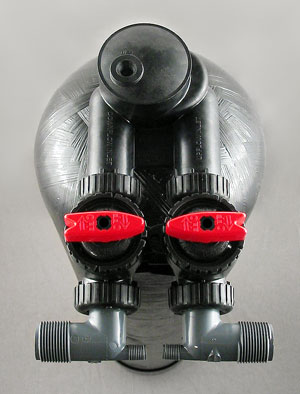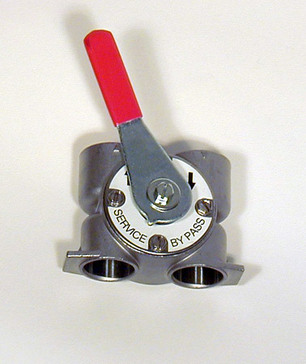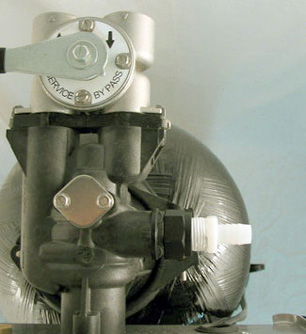How Bypass Valves Work

How Bypass Valves in Water Filters Work
The purpose of bypass valves on water treatment devices is to allow the user to easily divert water around the treatment device. The usefulness of this feature can be easily seen. For example, if a city water whole house dechlorinating filter owner wishes to water his trees and does not want to burden his filter with by having it treat his irrigation water he can simply turn a valve on the back of his filter and send the irrigation water around rather than through the filter. Of if a homeowner needs a repair part for a filter, he can simply divert water around the filter and he will have water, unfiltered water, but water nevertheless, during the week he's waiting for his replacement part. Without the bypass, he would have to remove the water filter, make a patch in his pipes, then reinstall the filter when his part arrived.
The picture at the top of the page shows a standard Clack bypass valve installed on an "in/out" filter. The red handles turn to direct water through the filter or around it. The valve can also be installed so that it will provide a convenient water shutoff for the whole house.
 |
|---|
| Above is a Fleck bypass that can be used with many Fleck filter and softener controls. The valve is mounted at the back of the filter. (See picture below.) The handle can point the small indicator arrow to either Service or Bypass position. Service is the normal setting. It means the filter is in service and water is being sent through the filter then to the home. |
 |
| The same Fleck bypass valve mounted on a Fleck 2510 Filter Control. The indicator is to bypass position, which means that water is taking a horsehoe turn inside the bypass valve rather than going through the filter. |
The bypass valves above are made by the valve manufacturer and sold as options to the control valves. Often, however, the bypass is fabricated from standard plumbing parts by the installer. The whole house installation below is a good example of a plumber-made bypass.
 |
|---|
This simple bypass is made with three ball valves. Flow is from the right in the picture. The picture shows the unit in Service position. Valves on the left and the right are open; center valve is closed. Water flows through the filter. To bypass, close the right and left valves and open the center. Water flows around the filter. The bypass will work without the left valve, but it's best to have both because it allows isolation of the filter completely from the house plumbing if desired. The filter is protected from freezing in winter with insulation and a moveable box. This filter is not pretty these days, but it has been in continuous trouble free service for over 10 years at this location. The bypass was built by a local plumber at the time of installation. |